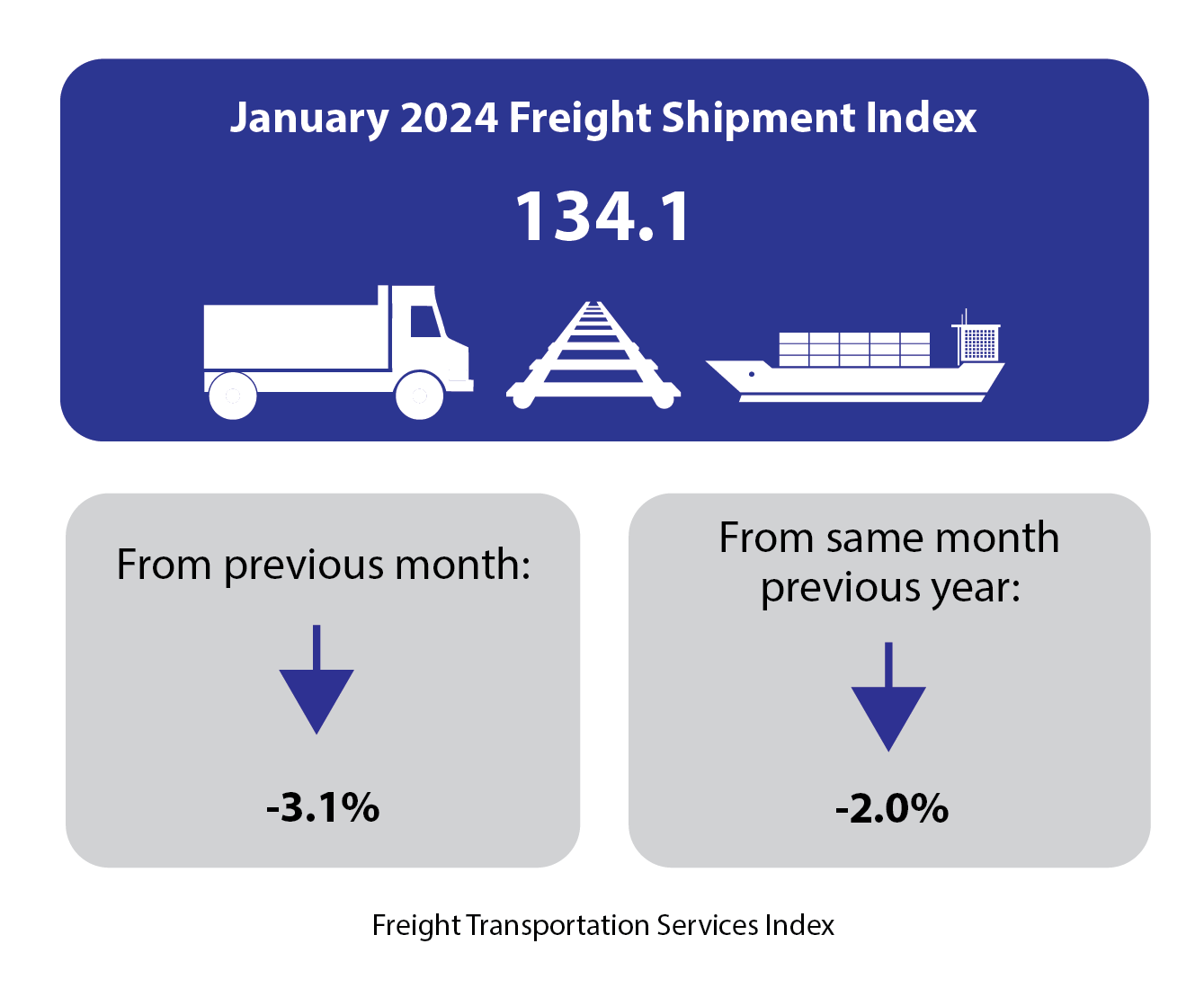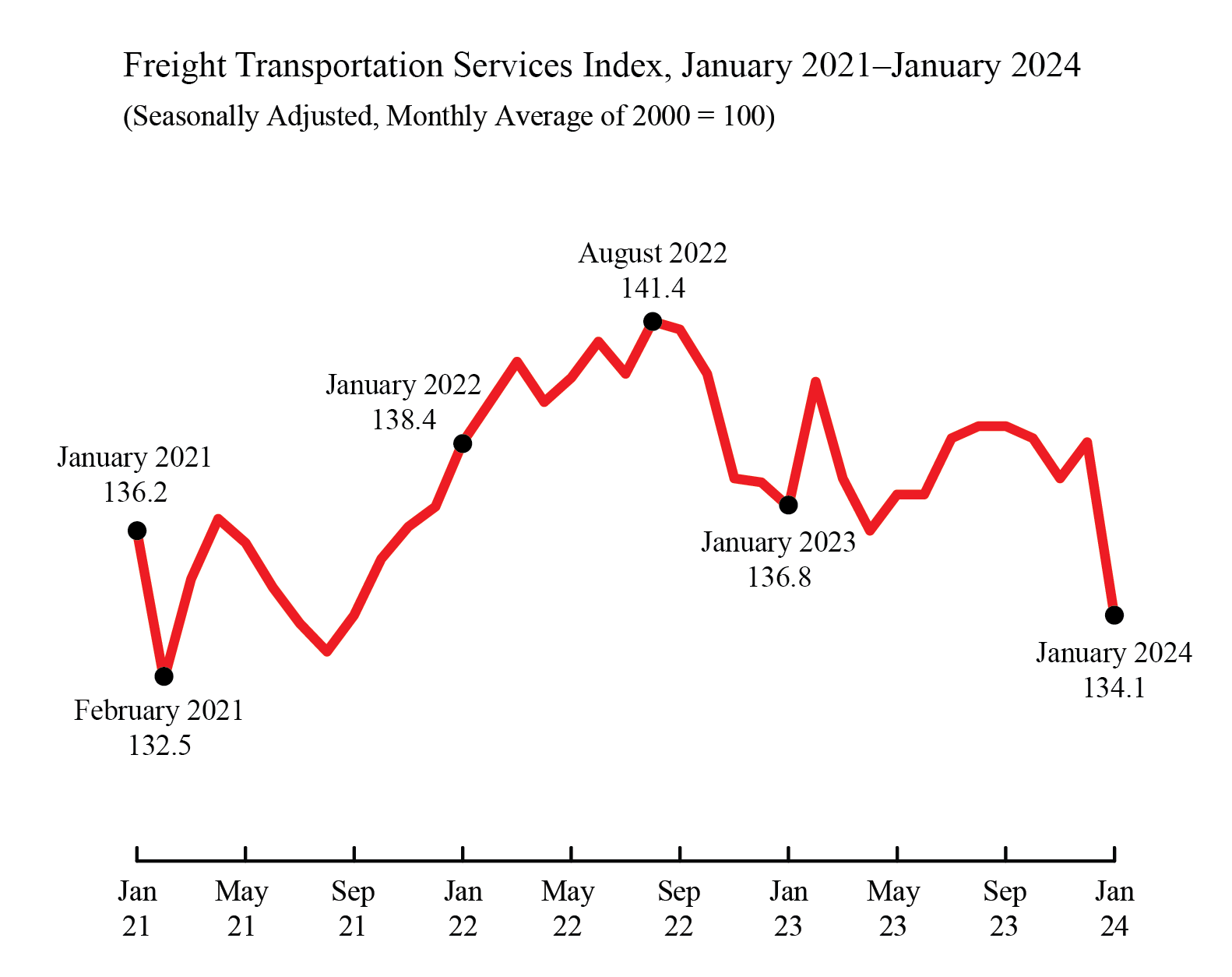January 2024 Freight Transportation Services Index (TSI) Down 3.1% from the Previous Month and Down 2.0% from the Same Month Last YearWednesday, March 13, 2024 BTS 12-24
The Freight Transportation Services Index (TSI), which is based on the amount of freight carried by the for-hire transportation industry, fell 3.1% in January from December, falling after a one-month increase, according to the U.S. Department of Transportation's Bureau of Transportation Statistics' (BTS). From January 2023 to January 2024 the index fell 2.0% (Tables 1, 2, and 2A).
The level of for-hire freight shipments in January measured by the Freight TSI (134.1) was 5.2% below the all-time high of 141.4 reached in August 2022 (Table 2A). BTS' TSI records begin in 2000. See historical TSI data. The December index was revised to 138.4 from 138.2 in last month's release. BTS will release the passenger and combined indexes for January next month, because air passenger travel continues to deviate from regular seasonal patterns, as it adjusts to the effects induced by the COVID-19 pandemic. The December passenger and combined indexes are available on the BTS website. Air freight for January is also a statistical estimate. Since air freight makes up a smaller part of the freight index, the freight TSI is being released as scheduled with the air freight estimate included. The Freight TSI measures the month-to-month changes in for-hire freight shipments by mode of transportation in tons and ton-miles, which are combined into one index. The index measures the output of the for-hire freight transportation industry and consists of data from for-hire trucking, rail, inland waterways, pipelines and air freight. The TSI is seasonally-adjusted to remove regular seasonal movement, which enables month-to-month comparisons. Analysis: The Freight TSI decreased in January due to seasonally adjusted decreases in trucking, air freight, rail carload, rail intermodal, and water while pipeline grew. The January decrease came in the context of mixed results for several other indicators. The Federal Reserve Board Industrial Production (IP) Index declined by 0.1% in January, reflecting decreases of 2.3% in mining and 0.5% in manufacturing, while utilities grew by 6.0%. Housing starts were down 14.8% while personal income increased by 1.0%. The Institute for Supply Management Manufacturing (ISM) index was up 2 points to 49.1, indicating that decline in manufacturing was slowing. (A reading above 50 indicates an expansion of U.S. manufacturing, while a reading below 50 indicates a contraction) Although the January Passenger TSI is being withheld because of the previously cited difficulty of estimating airline passenger travel and other components, the December index is now being released. The index increased 2.1% from November to December. Seasonally adjusted transit, air passenger and rail passenger all grew. The Passenger TSI has now exceeded its level in March 2020 —the first month of the pandemic— for thirty-one months in a row but remains below its pre-pandemic level (February 2020) for the 46th consecutive month. Trend: The January freight index decrease was the largest decrease since April 2020 near the beginning of the COVID-19 pandemic. It was the third decrease in five months, for a total decrease of 3.4% since August. The index increased 0.7% since August 2021. The January Freight TSI exceeds the pandemic low in April 2020 by 8.1%; the index increased month-over-month in 26 of the 45 months since that low. For additional historical data, go to TSI data. Index highs and lows: For-hire freight shipments in January 2024 (134.1) were 41.2% higher than the low in April 2009 during the recession (95.0). The January 2024 level was 5.2% below the historic peak (since 2000) reached in August 2022 (141.4) (Table 1A). Year to date: For-hire freight shipments measured by the index were down 3.1% in January compared to the end of 2023 (Table 3). Long-term trend: For-hire freight shipments are down 2.8% in the five years from January 2019 and are up 15.3% in the 10 years from January 2014 (Table 5). Same month of previous year: January 2024 for-hire freight shipments were down 2.0% from January 2023 (Tables 4, 5). The TSI has three seasonally-adjusted indexes that measure changes from the monthly average of the base year of 2000. The three indexes are freight shipments, passenger travel and a combined measure that merges the freight and passenger indexes. See Seasonally-Adjusted Transportation Data for numbers for individual modes. TSI includes data from 2000 to the present. Release of the February 2024 index is scheduled for April 10, 2024. Revisions: Monthly data has changed from previous releases due to the use of concurrent seasonal analysis, which results in seasonal analysis factors changing as each month's data are added. BTS research has shown a clear relationship between economic cycles and the Freight and Passenger Transportation Services Indexes. See a study of this relationship using smoothed and detrended TSI data. Researchers who wish to compare TSI over time with other economic indicators, can use the FRED database, which includes freight, passenger and combined TSI, and which makes it possible to easily graph TSI alongside the other series in that database. See TSI data on FRED. For charts and discussion on the relationship of the TSI to the economy, see Transportation as an Economic Indicator: Transportation Services Index. A BTS report explaining the TSI, Transportation Services Index and the Economy, is available for download. Table A: Summary of Revisions to Freight TSI in Previous 12 Months
SOURCE: Bureau of Transportation Statistics. See Transportation Services Index for documentation, data and other background information. Table 1: Freight Transportation Services Index since July 2023
SOURCE: Bureau of Transportation Statistics. See Transportation Services Index for documentation, data and other background information. Table 1A: Annual High and Low Points in Freight Transportation Services Index, 2009-2024
SOURCE: Bureau of Transportation Statistics. See Transportation Services Index for documentation, data and other background information.
Table 2: Freight Transportation Services Index Monthly Changes, 2021-2024
SOURCE: Bureau of Transportation Statistics. See Transportation Services Index for documentation, data and other background information.
Table 2A: Freight Transportation Services Index by Month, 2021-2024
SOURCE: Bureau of Transportation Statistics. See Transportation Services Index for documentation, data and other background information.
Table 3: Freight Transportation Services Index Year-to-Date Change, 2015-2024
SOURCE: Bureau of Transportation Statistics. See Transportation Services Index for documentation, data and other background information.
Table 4: Freight Transportation Services Index from Year-to-Year
SOURCE: Bureau of Transportation Statistics. See Transportation Services Index for documentation, data and other background information. Table 5: Freight Transportation Services Index from Previous Years
SOURCE: Bureau of Transportation Statistics. See Transportation Services Index for documentation, data and other background information.
Brief Explanation of the TSI The TSI tells us how the output of transportation services has increased or decreased from month to month. The index can be examined together with other economic indicators to produce a better understanding of the current and future course of the economy. The movement of the index over time can be compared with other economic measures to understand the relationship of changes in transportation output to changes in Gross Domestic Product (GDP). The index does not include international or coastal waterborne movements, private trucking, courier services, or the US Postal Service. The index does not include intercity bus, sightseeing services, ferry services, taxi service, private automobile usage, or bicycling and other non-motorized transportation. The TSI includes only domestic "for-hire" freight and passenger transportation. For-hire transportation consists of freight or passenger transport services provided by a firm to external customers for a fee. The TSI does not include taxi services, paid ride services in personal motor vehicles (e.g., Uber, Lyft, etc.), intercity bus services, in-house transportation (vehicles owned and operated by private firms for their own use), or noncommercial passenger travel (e.g., trips in the household car). | |||||||||||||||||||||||||||||||||||||||||||||||||||||||||||||||||||||||||||||||||||||||||||||||||||||||||||||||||||||||||||||||||||||||||||||||||||||||||||||||||||||||||||||||||||||||||||||||||||||||||||||||||||||||||||||||||||||||||||||||||||||||||||||||||||||||||||||||||||||||||||||||||||||||||||||||||||||||||||||||||||||||||||||||||||||||||
Beranda » Tanpa Label » January 2024 Freight Transportation Services Index (TSI) Down 3.1% from the Previous Month and Down 2.0% from the Same Month Last Year




0 Komentar untuk "January 2024 Freight Transportation Services Index (TSI) Down 3.1% from the Previous Month and Down 2.0% from the Same Month Last Year"